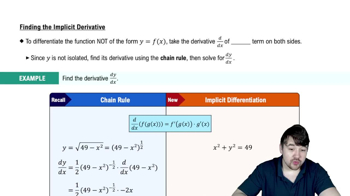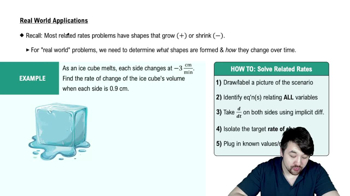Table of contents
- 0. Functions7h 52m
- Introduction to Functions16m
- Piecewise Functions10m
- Properties of Functions9m
- Common Functions1h 8m
- Transformations5m
- Combining Functions27m
- Exponent rules32m
- Exponential Functions28m
- Logarithmic Functions24m
- Properties of Logarithms34m
- Exponential & Logarithmic Equations35m
- Introduction to Trigonometric Functions38m
- Graphs of Trigonometric Functions44m
- Trigonometric Identities47m
- Inverse Trigonometric Functions48m
- 1. Limits and Continuity2h 2m
- 2. Intro to Derivatives1h 33m
- 3. Techniques of Differentiation3h 18m
- 4. Applications of Derivatives2h 38m
- 5. Graphical Applications of Derivatives6h 2m
- 6. Derivatives of Inverse, Exponential, & Logarithmic Functions2h 37m
- 7. Antiderivatives & Indefinite Integrals1h 26m
- 8. Definite Integrals4h 44m
- 9. Graphical Applications of Integrals2h 27m
- 10. Physics Applications of Integrals 2h 22m
4. Applications of Derivatives
Related Rates
Problem 96a
Textbook Question
The lateral surface area S of a right circular cone is related to the base radius r and height h by the equation S = πr√(r² + h²).
a. How is dS/dt related to dr/dt if h is constant?
 Verified step by step guidance
Verified step by step guidance1
To find how dS/dt is related to dr/dt when h is constant, we start by differentiating the given equation for the lateral surface area S with respect to time t.
The equation for the lateral surface area is S = πr√(r² + h²). Since h is constant, we treat it as a constant during differentiation.
Apply the chain rule to differentiate S with respect to t: dS/dt = d/dt [πr√(r² + h²)].
Differentiate the expression: dS/dt = π * (d/dt [r√(r² + h²)]). Use the product rule here, as the expression is a product of πr and √(r² + h²).
The derivative of r√(r² + h²) with respect to t is: (dr/dt)√(r² + h²) + (r * (1/2)(r² + h²)^(-1/2) * 2r * dr/dt). Simplify this expression to find the relationship between dS/dt and dr/dt.
 Verified video answer for a similar problem:
Verified video answer for a similar problem:This video solution was recommended by our tutors as helpful for the problem above
Video duration:
2mPlay a video:
Was this helpful?
Key Concepts
Here are the essential concepts you must grasp in order to answer the question correctly.
Related Rates
Related rates involve finding the rate at which one quantity changes in relation to another. In this context, we are interested in how the lateral surface area S of a cone changes with respect to the radius r while keeping the height h constant. This requires applying the chain rule to differentiate the equation with respect to time.
Recommended video:

Intro To Related Rates
Chain Rule
The chain rule is a fundamental principle in calculus used to differentiate composite functions. When dealing with related rates, the chain rule allows us to express the derivative of a function in terms of the derivatives of its variables. For the equation S = πr√(r² + h²), we will differentiate S with respect to time t, leading to a relationship between dS/dt and dr/dt.
Recommended video:

Intro to the Chain Rule
Implicit Differentiation
Implicit differentiation is a technique used to differentiate equations where the dependent and independent variables are not isolated. In this problem, we will treat S as a function of r and h, and since h is constant, we can differentiate S implicitly with respect to t. This will help us find the relationship between the rates of change of S and r.
Recommended video:

Finding The Implicit Derivative
Related Videos
Related Practice





